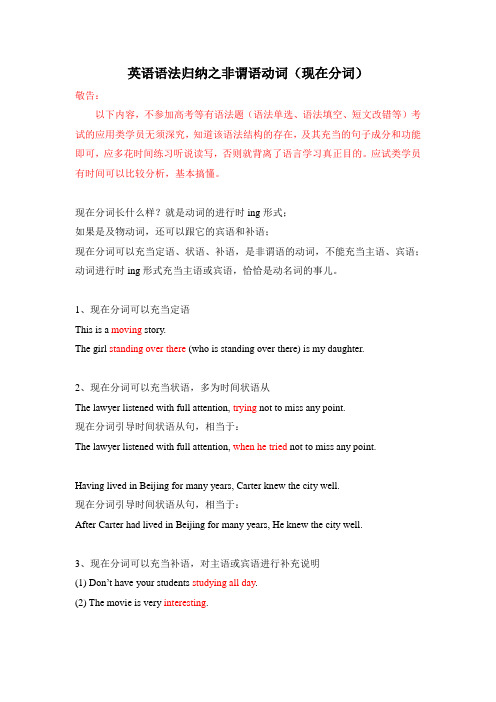14.突破语法知识—非谓语动词之现在分词-讲义
- 格式:pdf
- 大小:302.45 KB
- 文档页数:11

人教版英语九年级复习之非谓语动词(动名词、分词)非谓语动词是指在句中充当除谓语以外的其他句子成分的动词形式,可作主语、宾语、表语、定语、状语、补足语等,在句中起名词、形容词、副词的作用。
非谓语动词包含三种形式:动词不定式、动名词和分词(现在分词和过去分词)。
考点一:动名词动名词,即动词-ing形式动词的-ing形式由“动词原形+-ing”构成,其否定形式为“not+动词的-ing形式”。
动词的-ing形式在句中可以作主语、宾语、表语、定语、宾语补足语等。
1、作主语动名词作主语,谓语动词用单数,大多数情况下可以和不定式互换Watching TV too much is a waste of time. = To watch TV too much is a waste of time.看电视太久是在浪费时间。
典型例题:1._________ an English club ______ a good way to improve English.A.Joining; isB. Join; areC. To join; isD. Joins; are2. ________ lots of vegetables ________ good for our health.A. Eating; isB. Eat; areC. To eat; isD. Eats; are参考答案:1.A 2. A2、作宾语。
(1).在初中阶段我们需要掌握的后跟动词-ing形式作宾语的词语有dislike, consider, enjoy, finish, imagine, keep, mind, practice, suggest, give up, put off, keep on, be busy, have fun, be afraid of, be good at, be interested in, be \get used to, look forward to, feel like, thanks for等。


现在分词做非谓语动词讲解分词作为非谓语动词是句子中常见的一种语法结构。
分词有两种形式:现在分词(-ing形式)和过去分词(-ed形式)。
现在分词作为非谓语动词时,它可以用来修饰名词或代词,也可以用来表示主动的主语所具有的动作或状态。
下面是一些现在分词作为非谓语动词的常见用法和相关参考内容。
1. 现在分词作主语补语现在分词可以作为主语补语,用来补充解释或说明主语的特征、性质或状态,常见的结构有:- It/This/That/There/They/We + be + 现在分词- 名词 + be + 现在分词例句:- It is fascinating watching the sunset over the ocean.- This book is really interesting reading.参考内容:- "Grammar in Use" by Raymond Murphy- "Practical English Usage" by Michael Swan- "English Grammar in Use" by Raymond Murphy2. 现在分词作宾语补语现在分词可以作为及物动词的宾语补语,用来修饰宾语,表示被动的动作或状态。
常见的结构有:- 动词 + 宾语 + 现在分词例句:- I found the article quite confusing.- She considers singing in public a great achievement.参考内容:- "English Grammar and Usage" by Leech and Svartvik- "Collins COBUILD English Guides" by John Sinclair- "A Comprehensive Grammar of the English Language" by Randolph Quirk et al.3. 现在分词作状语现在分词可以作为状语,修饰整个句子或者句子中的某个成分,表示时间、原因、方式、条件等。

英语语法归纳之非谓语动词(现在分词)敬告:以下内容,不参加高考等有语法题(语法单选、语法填空、短文改错等)考试的应用类学员无须深究,知道该语法结构的存在,及其充当的句子成分和功能即可,应多花时间练习听说读写,否则就背离了语言学习真正目的。
应试类学员有时间可以比较分析,基本搞懂。
现在分词长什么样?就是动词的进行时ing形式;如果是及物动词,还可以跟它的宾语和补语;现在分词可以充当定语、状语、补语,是非谓语的动词,不能充当主语、宾语;动词进行时ing形式充当主语或宾语,恰恰是动名词的事儿。
1、现在分词可以充当定语This is a moving story.The girl standing over there (who is standing over there) is my daughter.2、现在分词可以充当状语,多为时间状语从The lawyer listened with full attention, trying not to miss any point.现在分词引导时间状语从句,相当于:The lawyer listened with full attention, when he tried not to miss any point.Having lived in Beijing for many years, Carter knew the city well.现在分词引导时间状语从句,相当于:After Carter had lived in Beijing for many years, He knew the city well.3、现在分词可以充当补语,对主语或宾语进行补充说明(1) Don’t have your students studying all day.(2) The movie is very interesting.现在分词有多种体现时态和语态的形式:1、现在分词的一般式(doing)通常表示其动作与谓语动词的动作同时发生。


高中英语语法专题复习03 非谓语动词(不定式、动名词&现在分词、过去分词)非谓语动词谓语动词在句子中有三种作用:1. 表示动作的时间,tense (时)2. 表示动作的状态,aspect (体)3. 表示动作的语气,mood (气)谓语动词的“时体气”,通过动词变位实现。
例如,The rabbit ate a carrot.The rabbit is eating a carrot.The rabbit has eaten a carrot.谓语动词在句子中受到主语的限制,随之出现了时态和人称的变化,成为一种被限定了的动词,所以也被称为限定性动词(finite verb)。
与之相对的,不受主语限制的动词,称为非限定性动词(non-finite verb),也就是非谓语动词。
非谓语动词不具备表达时态和人称的作用。
例如,I like to eat carrot.I liked eating carrot.The rabbit likes minced carrot.非谓语动词有四种形式:1. 不定式 infinitive2. 动名词 gerund3. 现在分词 present participle4. 过去分词 past participle谓语动词是简单句的核心动词,非谓语动词只可能出现在其他的句子成分中。
1. 主语例:Swimming makes us hale and hearty.2. 宾语例:Janet suddenly stopped talking.3. 表语/主语补语例:Her wish is to become a doctor in the future.4. 宾语补语例:I invited him to come here.5. 定语例:Don't disturb the sleeping dog.6. 状语例:He went to the supermarket to buy a pen.不定式、动名词句子的核心动词只能由谓语动词充当,而非谓语动词可以充当句子的其他成分。
高中英语新高考语法专题学习讲义非谓语动词语法(现在分词和过去分词)知识点总结现在分词•名称:现在分词 (Present Participle)•形式:原动词后加 -ing 后缀 (v. + -ing)•范例:原型→ play;现在分词→ playing•词性:形容词性或副词性•形容词性现在分词的表意:做着某事的(如:playing 可表达“玩耍着的”)•副词性现在分词的表意:做着某事(如:playing 也可表示“玩耍着”)形容词性现在分词例句:) is (系) a Boeing 777 (表).正飞过我们头顶的飞机是一架波音 777。
Somebody (主) is trapped (谓) in that burning house (有人被困在那栋燃烧着的房子里。
形容词性的现在分词往往在句子中承担定语的角色。
作为定语,现在分词既可以前置也可以后置,也就是说,既可以在被限定的名词之前,也可以在其后。
比如以上的两个例句中,第一句的 flying over our head 用来限定它前面的 the aircraft,而第二句中的 burning 限定的却是它后面的 house。
副词性现在分词例句:He (主) took (谓) a glance (宾), thinking of the girl he once knew.他看了一眼,想着以前认识的那个女孩。
Considering your health, you (主) had better have (谓) a rest (宾).考虑到你的身体状况,你最好歇一会儿。
副词性的现在分词在句中作非谓语动词时,表达的意思往往有“一边……一边做着某事”的感觉。
比如第一句例句,我们也可以将它翻译为“他一边看了一眼,一边想着以前认识的那个女孩”。
第二句其实同样可以先初步翻译为“一边考虑着你的健康,你最好歇一会儿”,然后通过理解和重新组织,将它进一步优化为“考虑到你的身体状况,你最好歇一会儿”。
高考英语非谓语动词之分词讲解一、考点分析非谓语动词在语法填空中最为常见,在翻译句子中也有所涉及;如学生基础较好,能在写作中运用,那将为作文提升一个档次。
二、专题详解分词是一种非谓语动词形式。
分词有现在分词和过去分词两种。
分词既具有动词的一些特征,可自带状语,有自己的逻辑主语,现在分词还可以带宾语,有时态和语态的变化。
它同时又具有形容词和副词的句法功能,可以作主语、表语、定语、状语,也可以用于复合结构作宾语补足语等。
1)知识点1作表语1.作表语的分词2.常用的作表语的分词注:大多数作表语的过去分词都来自及物动词,只有一小部分来自不及物动词。
例如:gone, come,fallen, risen,arrived, returned, passed, changed, faded等,这些主要是表示运动及转变的不及物动词,它们用作表语时带有书面语色彩,而且使用范围很窄。
例如:Summer is gone. 夏天过去了。
Autumn is come. 秋天到了。
The leaves are fallen.树叶落了。
The sun is risen.太阳升起来了。
3.过去分词作表语与被动语态的区别有些过去分词用作表语时,构成的谓语很接近被动结构。
一般说来with,at等介词多用于表语结构,by多用于被动结构.。
例题及练习基础题:1. There was a terrible noise______ the sudden burst of light.A followedB followingC to be followedD being followed答案:B2. The news was so ______that they were all____.A. inspiring; excitingB. inspiring; excitedC. inspired ;excitedD. inspired ;exciting 答案:B3. The door of the shop remained _____,though it was ten o’clock a.m.A.openedB. openingC. lockedD. having locking 答案:C4. I’d rather read than watch television; the program seem ______all the time .A.to get worseB.to be getting worseC.to have got worseD. Getting worse答案:B2)知识点2作定语1.分词作定语,修饰名词,相当于一个定语从句。
14.突破语法知识—非谓语动词之现在分词一、动词-ing形式概述动词-ing形式包括现在分词(the present participle)和动名词,是三种非谓语动词之一。
现在分词既具有动词的一些特征,又具有形容词和副词的句法功能。
动名词既具有动词的一些特征,又具有名词的句法功能。
动词-ing形式的功能动词-ing的形式:1.He hurried home,looking behind as he went.2.Having finished their work,they had a rest.3.The large building being built is a library.4.Having been shown the lab,we were taken to see the library.二、现在分词的两个基本特点1、在时间上表示动作正在进行There are many sleeping students in class.2、在语态上表示主动Feeling the lesson is boring,the students are sleepy.三、现在分词的构成1、一般动词,变化:加+ing,例子:wash——washing,read——reading2、以不发音字母e结尾的动词,变化:去掉e,再加+ing,例如:make——making write——writing use——using3、以重读闭音节结尾的动词且末尾只有一个辅音字母,变化:双写最后的辅音字母,再加+ing,例如:run——running,swim——swimming,put——putting4、以ie结尾的动词,变化:改ie为y,再加+ing,例如:lie——lying,die——dying,tie——tying5、以c结尾的动词,变化:变c为ck,再加+ing,例子:picnic→picnicking,traffic→trafficking(例外:arc 作弧形运动,arcing)6、以l结尾的动词,变化:如果动词原形以非重读音节结尾,则末尾的字母l双写与不双写均可。
其中不双写的是美式拼写。
tavel→travelling/traveling(U.S.)7、以x、w、y结尾的动词,直接加ing。
例如:原词:fix+ing→fixing(修理)原词:follow+ing→follow(跟随)原词:employ+ing→employing(雇用)8、例外(双写辅音字母和直接加ing),单音节单词中有两个元音的动词无需双写n。
原词:iron+ing→ironing(熨烫)9、以元音字母加e结尾,或以e结尾,且e发音的动词(ee,oe,ye),直接加ing。
例如:原词:be+ing→being(做)原词:see+ing→seeing(看见)原词:free+ing→freeing(释放)10、以不发音字母e结尾的动词,先去掉e,再加ing。
例如:原词:ride→去e+ing→riding(骑)以字母ie结尾的动词,先将变ie为y,再加ing。
例如:原词:lie→先将ie变为y+ing→lying(躺)原词:tie-→先将ie变为y+ing→tying(系)原词:die→先将ie变为y+ing→dying(死)11、以c结尾的动词,变c为ck,再加+ing。
例如:原词:picnic→c变为ck+ing→picnicking(野餐)原词:traffic→c变为ck+ing→trafficking(交易)原词(例外):arc+ing→arcing(电弧放电)四、现在分词的功能作用1、作定语:现在分词作定语,当分词单独做定语时,放在所修饰的名词前;如果是分词短语做定语放在名词后。
例如:In the following years he worked even harder.在后来的几年中,他学习更努力了。
The man speaking to the teacher is our monitor's father.正与老师谈话的那个人是我们班长的父亲。
现在分词作定语相当于一个定语从句的句法功能,如:in the following years也可用in the years that followed,the man speaking to the teacher可改为the man who is speaking to the teacher.2、现在分词作表语:The film being shown in the cinema is exciting.The present situation is inspiring."be+doing"既可能表示现在进行时,也可能是现在分词做表语,它们的区别在于"be+doing"表示进行的动作是进行时,而表示特征时是系动词be与现在分词构成系表结构。
3、作宾语补足语以下动词后可跟现在分词作宾语补足语:see,watch,hear,feel,find,get,keep,notice,observe,listen to,look at,leave,catch等。
Can you hear your sister singing the song in the next room?Tom kept the car waiting at the gate.4、现在分词作状语①作时间状语(While)Working in the factory,his father was an advanced worker.(2018·全国卷Ⅱ)China's approach to protecting its environment while________(feed)its citizens“offers useful lessons for agriculture and food policymakers worldwide,”says the bank's Juergen Voegele.②作原因状语Being a Party member,he is always helping others.③作方式/伴随状语,表示伴随He stayed at home,cleaning and washing.练习:(2019·全国卷Ⅲ)We were invited to attend a private concert on a beautiful farm on the North Shore under the stars,________(listen)to musicians and meeting interesting locals.④作条件状语(If)Playing all day,you will waste your valuable time.⑤作结果状语:He dropped the glass,breaking it into pieces.⑥作让步状语Though raining heavily,it cleared up very soon⑦如果分词的逻辑主语与句子主语不一致,可采用分词独立结构作状语。
分词独立结构则:"名(代)词+现在分词"构成,可在句子中作状语,表示时间、原因、条件、伴随状况等。
Class being over,the children went home.Nobody being in the room,I didn't go in.Weather permitting,we'll start tomorrow.He went to the front door,his son following him.⑧注意固定结构的分词独立成分作状语:现在分词独立成分一般已形成固定结构,表示说话人对说话内容所持的态度或看问题的态度。
Generally speaking,we don't agree with you.Considering his age,the child reads quite well.Judging from what you say,he ought to succeed.但to tell the truth,to be sure,to be exact要用不定式。
总结:现在分词或分词短语做状语时,可以表示时间、原因、条件、让步、方式或伴随状况,通常可以转换成相应的状语从句,表方式或伴随状况时可以转换成并列句或非限制性定语从句。
5、现在分词和过去分词的用法区别6、分词的两个结构(1)否定结构:not+分词例如:Not having known his address,I didn’t write to him.(2)复合结构(独立主格结构)有两种形式:A、名词(代词主格)+分词(只作状语)It being Sunday,we don’t go to school.The day’s work done,they went home.他们做完一天的工作就回家了。
He sat there with his feet pointing to others.他坐在那儿把脚指向别人。
7、现在分词的时态和语态形式①现在分词完成时态的被动结构有时等于一个过去分词(即having been done=done)。
②现在分词的完成时态不能作表语、定语和宾补,只放在状语的位置上。
③现在分词一般时态的被动结构(being+v.-ed)表示“正在被”之意,而在动名词中只表示被动。
8、seat/dress这两个动词后如有宾语用现在分词,反之用过去分词。
include/consider这两个动词如果放在名词之前用现在分词,名词之后用过去分词。
例如:We went there,including our boss.We went there,our boss included.missing/remaining作“丢失的”和“剩下的”讲,只有现在分词形式;left作“剩下的”讲只能放名词后或代词后。
There are only five students left in the room.五、动名词的功能作用1、动名词的主动和被动主动:doing被动:动名词被动的时态(1)被动一般式――句子的主语是动名词(被动式)的逻辑主语如:He came in without being asked.He dislikes being interrupted in his experiment.He came to the party without being invited.(2)被动完成式――动作在谓语动词动作之前发生如:She doesn’t remember having ever been given a chance to go abroad.她不记得曾经被给予过一次出国的机会。